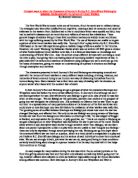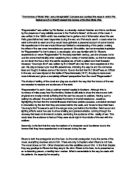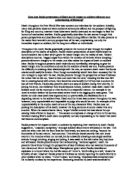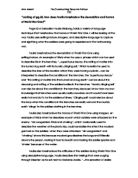An easy escape for many soldiers during the war was drink. For an ordinary private on the front line getting alcohol was hard and they were only allowed a small drop before going over the top, however officers were allowed to drink (as believed responsible enough for it) and alcoholism among officers was common. Both Stanhope in Journey’s End and Wraysford and Weir in Birdsong use drink as a method of getting through the horrors in front of them, ‘She doesn’t know that if I went up those steps into the front line – without being doped with whisky – I’d go mad with fright’. Drink was a way to forget, and maybe for a moment be away from the front line in their heads, although eventually become addicted not needing it for any purpose but for wanting, ‘cast his eyes round hopefully. Stephen reluctantly pushed a bottle towards him’. Drink was not the best way to deal with the situation though, it may have clouded their memories but would not have completed erase them ‘if sleep came it was as a gift and was as likely to come after tea as after alcohol’.
Soldiers on the front line could turn on each other, either because of alcohol consumption or just the fact that these men were pushed together in such bad conditions. Maybe getting angry at one another would give them something other than fighting the enemy to focus on ‘Hibbert raises his stick and strikes blindly at Stanhope’. The violence shown in Journey’s End could also represent the battles taking place outside, as an audience member you never get to see any conflict between the enemy and therefore Stanhope’s arguments and fights with the soldier’s substitutes this. The anger Stanhope feels towards Hibbert and also Raleigh, could also show us how he feels and acts in battle situations. Unlike Journey’s End in Birdsong we are able to follow Stephen as he goes out into No-man’s land, fighting for his life but we also get violence in the trenches too ‘Fuck off, Weir, fuck off out of my way’. The use of the word ‘fuck’ is a powerful one; we can understand Wraysford’s fear just through that one word, all his fear for the battle ahead builds up the tension. In Journey’s End Stanhope is worried about what Raleigh would write home in his letter, I believe that maybe another matter that Stanhope uses to redirect his thoughts away from memories, it gives him something else to think about. Which again leads to more violence ‘D’you understand an order? Give me that letter!’
Despite these small areas of conflict there is a strong theme in both Journey’s End and Birdsong, of comradeship. Men on the front line were often forced into forming new relationships with people and often because of this gained extraordinarily strong bonds with men they were fighting alongside with. This is shown by the example of Stanhope and Osborne, and shown to the audience in many scenes but mostly through the touching goodbye scene before the fatal raid and right at the end Stanhope and Raleigh final bond over his death, ‘Stanhope sits with one hand on Raleigh’s arm’ they had fought together in the same battles and known what the other men had seen, they understood. In Birdsong the strong relationship between Wraysford and Weir grew throughout the novel and like many soldiers on the frontline Wraysford needed Weir for company and to help his sanity, ‘Weir alone had made the war bearable’ friendships like Weir’s and Wraysford’s meant that soldiers could get through the war together. They did not need to be alone. Although Raleigh in Journey’s End believed he needed to distance himself when Osborne dies, Raleigh who is first seen as this innocent character in the beginning of the play is opened to this horror after the death of Osborne, he now knows truly just how hard . He eats away from the officers with the other men, he finds it disrespectful that the others are eating and drinking. Maybe some may believe distancing themselves would mean when or if it came to them dying it would not be as hard.
Many soldiers needed to be friends, to join together because even though loss is hard the sharing of jokes in such a situation as terrible as this one may have helped. In Journey’s End many of the characters particularly Trotter’s main form of escapism is in making jokes about the war and the Germans ‘I expect a nasty old German’ll cop out of it and say, ‘Ock der Kaiser’ in doing this they are able to cover up their fear and make light of the situation. In Birdsong the use of comedy is more subtle, the soldiers go down to the pub and watch entertainment and laugh with each other as friends rather than making obvious jokes. Jack performing for the soldiers gave some time for the men to relax and enjoy themselves. ‘If they could shout loud enough, they might bring the world back to its senses; they might laugh loud enough to raise the dead’ although raising the dead was not possible, the idea that in laughing and having as good a time as you can they could remember their losses and keep them alive in their thoughts.
In Journey’s End some of the soldiers liked to talk about home and familiar things like rugby and cricket to take their minds of the horrors of trench warfare. Thinking about home would help them to remember how their life was before the war; it would make them want to get out and gave them something to live for. Another thing they might think about is their girlfriends, wives or just women in general, ‘I just prayed to come through the war – and – and do things – and keep absolutely fit for her’. Jack Firebrace wanted to survive for his family, dealt with the struggle with the belief he had his wife and child to return to ‘His endurance was for them; the care he took to try to stay alive was so that he would see the boy again’. As for Stephen he did not have a family or anyone really he wanted to go home for, he kept on fighting and wanting to survive for the men who had died before, he wanted to win, to continue for their benefit. The idea and hope that the men he had lost had not died in vain.
With trench conditions as foul as they were; rats, lice and illnesses such as trench foot one thing that could keep the men going was the idea and the relief of getting food. The importance of food in Journey’s End is shown by how many times the men talk about it and bring it up in general conversation. Complaining about inconsequential things like chunks of pineapple instead of apricots take their minds of the war ‘I say, Stanhope, it’s a terrible business. We thought we’d got a tin of pineapple chunks; it turns out to be apricots’. The men on the front lines wouldn’t very often have the nicest of food, and when Stanhope has to visit the Colonel and is given really expensive foods he immediately thinks of his men but he will eat the food as it is the one thing that he can gain pleasure from ‘A thin stew followed, then ripe cheese and fresh bread. Lunch went on past three o’clock…Stephen smiled to himself, aware that his brief flight from reality would soon be ended’.
Birdsong touches on the idea of religion and how this can be affected by war. Many soldiers lost their faith due to the mass slaughter or even the loss of a son at home like Jack Firebrace however Stephen seemed to gain a belief in God, the idea that nothing this cruel can be the end. He hoped that when Weir or any other Soldier died they had a better world to escape to and maybe this idea kept him going helped him deal with the death of his friends. Journey’s End doesn’t really touch on the men’s faith or religion, however the idea of hero worshipping used by Raleigh could be linked. The belief in a God and a higher being could also be like Raleigh looking up to Stanhope ‘I believe Raleigh will go on liking you – and looking up to you – through everything. There’s something very deep, and rather fine, about hero worship.’ Many soldiers may have used the method of positive thinking like Osborne to cover up just how scared and fearful they were ‘I never knew the sun could rise in so many ways till I came out here’.
Each soldier on the front line had to choose their own way of escaping and dealing with the horrors of trench warfare. The putrid living conditions and the everyday horror of death meant that it was necessary for them to break out of the truth they were living. Many of the methods used in both Journey’s End and Birdsong are similar but their methods were carried out in different ways. Others didn’t use methods at all, they just didn’t cope; like Hibbert in Journey’s End faking an illness to get away. Each character in either Journey’s End or Birdsong took on different methods of dealing with their long hardships and suffering. The true horrors of the war however could not be forgotten, the sight of death and the stench in the trenches would not be quickly removed from their thoughts. These literary texts both play and book give us, today, just a brief insight into the lives of men on the western front, the challenges faced by these men were truly horrific and just surviving must have been a hardship. No one now or then on the home front could ever know the true extent of the struggle and the effects it had both mentally and physically, ‘If they could see the way these men live they would not believe their eyes. This is not a war; this is an exploration of how far men can be degraded.’







